Featured Articles
Three Myths Explored On The 40th Anniversary Of Foreman vs. Ali
It’s been 40 years since Muhammad Ali 44-2 (31) upset the boxing world as a 3-1 underdog and knocked out undisputed heavyweight champion George Foreman 40-0 (37) in the eighth round to become only the second fighter in history to reclaim the heavyweight title. Today, Ali, 72 and Foreman, 65, are America’s guest whenever they appear in public. With all the years and the passage of time, most have forgotten just how big of an event and fight Foreman-Ali was back on Oct. 29, 1974. Through the years there’s been so much discussed pertaining to the fight that it’s impossible to reveal anything that hasn’t already been hashed over ad-nauseum.
The fight took place in Kinshasa Zaire and was fought at the 20th of May Stadium. It was former Cleveland racketeer Don King’s first venture into big time boxing as a promoter and he titled it “The Rumble In The Jungle.” King used his gift of gab to coax all within his voice’s reach that the coming together of Foreman and Ali was symbolic. “The prodigal sons will be returning to Africa,” was his theme during the months leading up to the fight.
September 25th was the original scheduled date of the bout, but it was pushed back to October 29th when sparring partner Bill McMurray cut George over his right eye during a training session on September 16th. When the bout was postponed both Foreman and Ali were forced to remain in Zaire despite the fact that they both wanted to come back to the United States. However, the fast- thinking Ali turned the tables on Foreman and embraced staying there and roamed with the people of Zaire once word leaked out that George wanted to leave the country. In a short time Ali became a man of the people and by fight night Foreman felt as if an entire country was against him.
The fight started at four in the morning on Wednesday October 30th, 1974 in Zaire to accommodate audiences in the United States at ten in the evening Tuesday night October 29th. At the time George Foreman was thought to be the most unbeatable and invincible heavyweight champion in history. He demolished “Smokin” Joe Frazier in two rounds to capture the undisputed title in January of 1973. This was the same Frazier that Ali had to fight twice before he could claim a victory over him. In his second defense of the title Foreman mutilated Ken Norton in less than two full rounds in March of 1974, and yes, Ali needed to fight Norton twice before he could say he beat him. So the back-story for the “Rumble In The Jungle” was this: the only two fighters who ever defeated Ali just so happened to be two of Foreman’s easiest and most impressive victories. Foreman was often quoted saying in the weeks before the fight, “I hit a guy and it’s like magic. You see him crumbling to the floor. It is a gift from God.” And there were many astute boxing observers who saw Ali being the victim of the same fate. In fact it led George to believe that there was no way he could lose to Ali and it probably wouldn’t even be his toughest fight. If ever there was a supremely confident fighter before an historic bout, it was George Foreman before he fought Muhammad Ali.
The documentary “When We Were Kings” pretty much covered what transpired leading up to, during and after the “The Rumble In The Jungle.” However, there are three popular myths regarding the fight that neither the film nor anyone has ever really touched on or addressed. We start with the ring size, Foreman’s lack of a backup plan when the fight began to slip away from him, and the myth of Ali introducing the “Rope a Dope” strategy during the bout.
The Ring Size:
Much has been made about the loose ring ropes for the Foreman-Ali bout over the years. And yes they did have slightly more give than the ropes usually have around a boxing ring. And the reason for that was because the ropes were for a 19-foot ring. Before the fight Ali stressed he wanted a 20-foot ring and Foreman wanted a 19-foot ring. What they got in Zaire was a 16-foot ring. This is documented by the October 29, 1974 edition of the Milwaukee Sentinel, and countless interviews that referee Zack Clayton gave over the years after the fight. In fact this was discussed between me and Mr. Clayton when I mentioned it to him at the post fight press conference after Michael Spinks stopped Murray Sutherland in the eighth round on 4-11-82 to retain his WBA light heavyweight title in Atlantic City N.J. And Mr. Clayton confirmed to me that Foreman and Ali fought in a 16 foot ring in over 80 degree heat. He then added that he was somewhat surprised that, “Ali agreed to fight Foreman in a phone booth with ropes.”
The size of the ring was a definite benefit for Foreman because he knew the less room that Ali had to move and box the larger the advantage for him. The conventional wisdom before the fight was this: Ali would look to circle and box George from the outside, utilizing his superior hand and foot speed the way he did when he fought Sonny Liston and George Chuvalo the first time he fought them. Ali also circled and boxed and used the entire ring 20-foot ring for seven or eight rounds of his rematch with Joe Frazier in his last bout before challenging Foreman. As witnessed by re-watching the fight, Foreman easily crowds Ali after taking only three or four steps to either side in the smaller ring. One of the things Foreman worked on and stressed before the fight was his ability to cut the ring off and how that would force Ali to have to mix it up and trade punches with him. That was considered ring suicide against Foreman circa 1973-74. Aside from forcing Ali to wear cement boxing shoes during the fight, Foreman couldn’t have been blessed with a better advantage than fighting Ali in a 16 foot ring. The ropes may have been a little loose during the bout, but the size of the ring was a bigger issue and a huge plus for Foreman.
Foreman’s corner and strategy:
On the night that he defended his title against Muhammad Ali, George Foreman’s corner consisted of all-time boxing greats Sandy Saddler and Archie Moore, along with trainer Dick Saddler. Before the fight it was assumed in order for Foreman to beat Ali, all that it would take was for him to be turned loose when the bell rang. As long as George didn’t hit the referee he’d enjoy clear sailing and win the fight in a spectacular fashion. Back then Foreman was boasting about his two famous punches: the “anywhere punch,” as in, anywhere it lands it does damage and the “deep sleep” in the other hand. At the time the prevailing thought was, Ali isn’t strong enough nor is he young enough at age 32 to hold off Foreman, age 25, or dance and use his legs to avoid George’s two handed rampage. The thought that Foreman would need a plan “B” or have to adjust to what Ali did during the fight wasn’t even a consideration to anyone before the bout.
The dynamic of the fight changed towards the end of the first round when Foreman managed to blast Muhammad to the head and body, and Ali openly talked to and mocked George after getting hit flush. The thought that Ali wouldn’t crumble once George caught him good wasn’t even a remote possibility before the fight in Foreman’s mind. And as George has said countless times over the years, Ali drew from his ability to take his punch and became more confident, and conversely, George began to lose confidence in his ability to hurt or defeat Ali as the fight progressed. Yes, Ali used the “Rope a Dope” strategy during the fight, but in a 16 foot ring, it’s not like his legs and lateral movement would’ve been all that effective in neutralizing Foreman’s power and aggression. In essence, because of the small ring, Ali had no choice other than to fight Foreman the way he did.
Archie Moore stated that everything they did with George in training for the Ali fight was to get Muhammad to the ropes, to cut the ring and maneuver him against the ropes. What they didn’t work on was what to do once George got him there and for some unforeseen reason Ali was able to take George’s punch. What they overlooked, along with the rest of the experts was, Ali’s body and ring strength were equal to George’s even though he wasn’t as big of a puncher. As the fight proceeded it was obvious because of Foreman being the same height as Ali, his punches to the head were wide and from outside, making them easier for Ali to see, anticipate and pick off or parry. As opposed to, say, Joe Frazier who started his tighter shots from down low and came up with them, making it more difficult for Ali to see and defend.
Immediately after the fight Foreman’s corner was wrongly excoriated and unfairly criticized by many fans and media for not instructing George on what he should do because their “catch ‘n kill” style of attack wasn’t working. Ali was handling Foreman’s power and aggression and in the midst George was walking into Ali’s lead rights and lefts. However, there was nothing they could’ve instructed Foreman to do in the middle of the fight that would’ve altered the result. By the time Team Foreman realized that George wasn’t going to get the anticipated early knockout, the fight was four rounds old and Foreman was starting to tire from throwing the kitchen sink at Muhammad. Aside from urging Foreman to stop head hunting, there’s not much else they could’ve instructed him to do differently. Foreman’s biggest advantage over Ali was his overload of punching power, and if Ali could withstand his Sunday punches, which he did, Foreman wasn’t going to beat him. He certainly didn’t stand a chance of beating the faster hand and footed Ali by trying to out-box him or out point him from center ring.
Had Foreman eased up and not been so aggressive, he would’ve been throwing away his only path to victory in the fight. Foreman minus his aggression would’ve been a sitting duck for Ali’s fast hands and combinations. Had Foreman chose to box and fight more in a more measured way instead of going after Ali, Muhammad would’ve peppered him at will from outside the way he did George Chuvalo, Ernie Terrell and Mac Foster. If you remember, after George lost to Ali he returned to the ring 15 months later a more measured fighter under new trainer Gil Clancy. And he looked good against contenders like Ron Lyle, Joe Frazier, Scott LeDoux and Dino Dennis, fighters who had no means to get away from him while fighting on the move. Then he fought Jimmy Young. Against Young, Foreman fought much more measured than he did against Ali, hoping to conserve his energy and stamina. And what happened? Young peppered Foreman and won a decision over him because he never had to cope with the out of control wrecking machine that Ali had to confront. Jimmy never really had to address Foreman’s overwhelming power and strength because for most of the bout, George kept it under wraps looking to conserve his stamina and energy.
Try to imagine Foreman switching in the middle of the bout with Ali and fighting him like he did Jimmy Young. Ali was quicker, threw faster and harder combinations and had better legs than Young. Not to mention he was physically bigger and stronger. Had Foreman’s corner implored George to back off and pick his shots against Ali, sure, he might’ve lasted longer or even perhaps gone the distance – but he would’ve lost every minute of every round along with the fight.
So the reality is, Foreman’s corner shouldn’t be faulted for not having a plan “B” for George the night he fought Ali. The simple truth is, if Foreman couldn’t knock out Ali by forcing the fight and trying to make Muhammad fight and trade with him, he’s wasn’t going to beat him. There was nothing that Archie Moore, Sandy Saddler or Dick Saddler could’ve instructed Foreman to do in the middle of the bout, simply because there was no plausible plan “B” that they could’ve implemented to salvage the fight. As we learned, Foreman just didn’t match up with Ali.
The Introduction of “Rope A Dope” is a Myth:
Over the last 40 years since Ali defeated Foreman, the “Rope A Dope” strategy has been hailed as being some stroke of genius on Ali’s part that he invented on the fly during the fight. The “rope a dope” strategy was implemented by Ali during the second round of the fight. The strategy saw Ali go to the ropes and cover up with his guard high, thus allowing Foreman to punch at him. Sometimes Ali would get off a few quick one-twos in between Foreman’s already launched incoming bombs, hitting George squarely as he was coming in. And then George would reload and start the process all over again. Foreman used up a lot of his energy throwing looping punches at Ali looking to take his head off. Many of them grazed Ali and the ones that did get through, he took. Ali also out-wrestled Foreman in the clinches and held his head down by pushing on the back of his neck so George couldn’t get a good shot at him. This tired Foreman, along with Ali’s taunts of telling him to punch harder and calling him a big sissy. Finally in the eighth round Ali got off a beautiful combination that ended with a hard right hand to Foreman’s face and he went down. Foreman rose but didn’t beat the count and referee Zach Clayton waved the fight over.
Let it be noted that had any other fighter tried to beat Foreman using the “rope a dope” tactic that Ali employed against him, they would probably be beaten to death. The strategy worked for Ali because Muhammad was blessed with a concrete body and a cast iron chin. That, along with his very underrated mental toughness and constitution. The only fighter who could’ve beat George Foreman by allowing George to work him over, did. It would be suicide for any other “boxer” to try and duplicate what Ali did against the undefeated raging Foreman who didn’t believe anyone could stand up to his punch or beat him. The “rope a dope” worked against George Foreman and enabled Ali to regain the undisputed heavyweight title seven years after being stripped of it.
The myth of the “rope a dope” strategy is that Ali had used it unsuccessfully twice before he fought Foreman, only he didn’t name it. Ali tried to “rope a dope” Joe Frazier from the sixth round on during the “Fight Of The Century.” Only it didn’t work because Frazier’s shorter punches and everlasting stamina piled up points and won rounds. Frazier’s lower center allowed him to be in the perfect position to work Ali over to the body, and at the same time, stay low and slip many of Ali’s return shots to the head. Punching down and missing Frazier actually drained Muhammad’s stamina. Ali sought a quick knockout against Frazier, who was a slow starter. When he failed to get the quick execution, he realized that in order for him to finish the fight, he was going to have to pace himself and see if at the same time Frazier would punch himself out. Only Joe never slowed down and his body work against a stationary Ali against the ropes sapped Muhammad’s stamina. So the “rope a dope” strategy failed Ali the first time he tried it.
Ali also tried to “rope a dope” Ken Norton the first time they fought two years after he lost to Frazier. Ali didn’t think much of Norton as a contender and was in terrible shape for the bout. Ali thought he could toy with Norton and stop him whenever he wanted. Once he realized that that wasn’t going to happen and the fight was probably going to go the distance, he went to the ropes and tried to get Norton to punch himself out so he could come on late in the fight. In the process Ali suffered a broken jaw. Again, he fought off the ropes and tried to pick his spots, but like Frazier, Norton had built up a head of steam and never slowed down.
You’ll notice that after the “rope a dope” failed against Frazier and Norton the first time he fought them, Ali abandoned it for the rematches with both men. What he did was get himself into great shape and down to 212 pounds for both rematches. Ali was never that low in weight before or after his rematches with Frazier and Norton during his comeback in the 70s. And before both rematches he promised not to lay against the ropes and give away rounds. He promised to dance and use his legs and not be the stationary target he was the first time he fought Joe and Ken. And in both fights Ali boxed and danced beautifully for the first half of the fight and banked those rounds. He eventually came down off his toes for a few rounds, but just when Frazier and Norton started to get back into the fight, he started circling and moving again because he was in great shape. Down the stretch his movement and his ability to fight effectively in retreat, something he was great at, enabled him to even the score with the only two men who ever beat him.
Let it be said for the record that Muhammad Ali used his famous “rope a dope” strategy twice before he fought George Foreman, and it failed both times. The only difference is, Ali didn’t coin it the “rope a dope” after if failed against Frazier and Norton. What he said was, he needed to lay against the ropes and rest against Frazier and Norton because he was coming off a long layoff when he fought Frazier – and he wasn’t in top condition when he fought Norton.
It wasn’t until the “rope a dope” strategy finally prevailed for Ali against George Foreman that he smartly gave it a catchy name. That’s part of the genius of Muhammad Ali.
In closing, Ali used the “rope a dope’ strategy once after he fought Foreman, and that was during his first fight with Leon Spinks, a fight he lost. Guess what he said after fighting Spinks? He said I underestimated him and wasn’t in top condition, that’s why I laid back against the ropes and rested, hoping the inexperienced Spinks would tire. For the rematch a determined Ali was in great shape and danced and boxed for 11 of the 15 rounds the fight went. Ali won an overwhelming decision victory and became the first fighter in history to win the world heavyweight boxing title three times.
In hindsight the “rope a dope” strategy didn’t serve Muhammad Ali well. He was 1-3 in fights when he used it. However, the one time it worked for him just so happens to be the signature win of his stellar career And that was 40 years ago. We are getting old!
Frank Lotierzo can be contacted at GlovedFist@Gmail.com
-

 Featured Articles3 weeks ago
Featured Articles3 weeks agoAvila Perspective, Chap. 330: Matchroom in New York plus the Latest on Canelo-Crawford
-
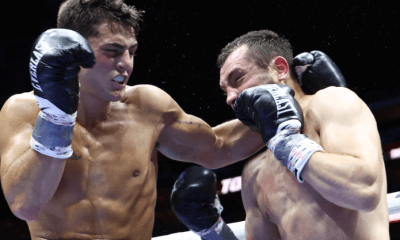
 Featured Articles2 weeks ago
Featured Articles2 weeks agoVito Mielnicki Jr Whitewashes Kamil Gardzielik Before the Home Folks in Newark
-
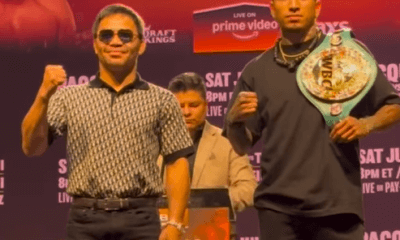
 Featured Articles4 weeks ago
Featured Articles4 weeks agoAvila Perspective, Chap 329: Pacquiao is Back, Fabio in England and More
-
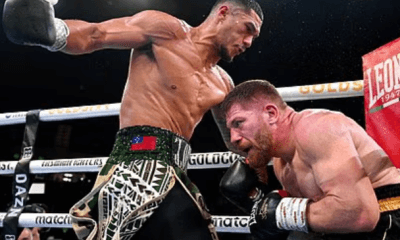
 Featured Articles4 weeks ago
Featured Articles4 weeks agoOpetaia and Nakatani Crush Overmatched Foes, Capping Off a Wild Boxing Weekend
-
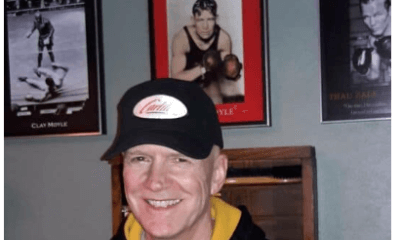
 Featured Articles3 weeks ago
Featured Articles3 weeks agoCatching Up with Clay Moyle Who Talks About His Massive Collection of Boxing Books
-

 Featured Articles4 weeks ago
Featured Articles4 weeks agoFabio Wardley Comes from Behind to KO Justis Huni
-
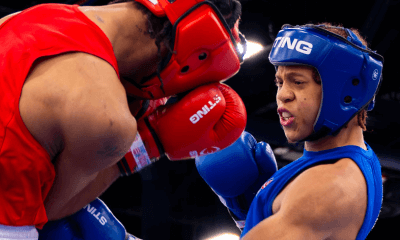
 Featured Articles2 weeks ago
Featured Articles2 weeks agoMore Medals for Hawaii’s Patricio Family at the USA Boxing Summer Festival
-
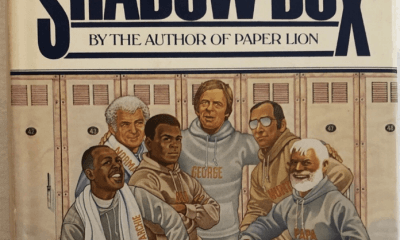
 Featured Articles4 weeks ago
Featured Articles4 weeks agoDelving into ‘Hoopla’ with Notes on Books by George Plimpton and Joyce Carol Oates
















